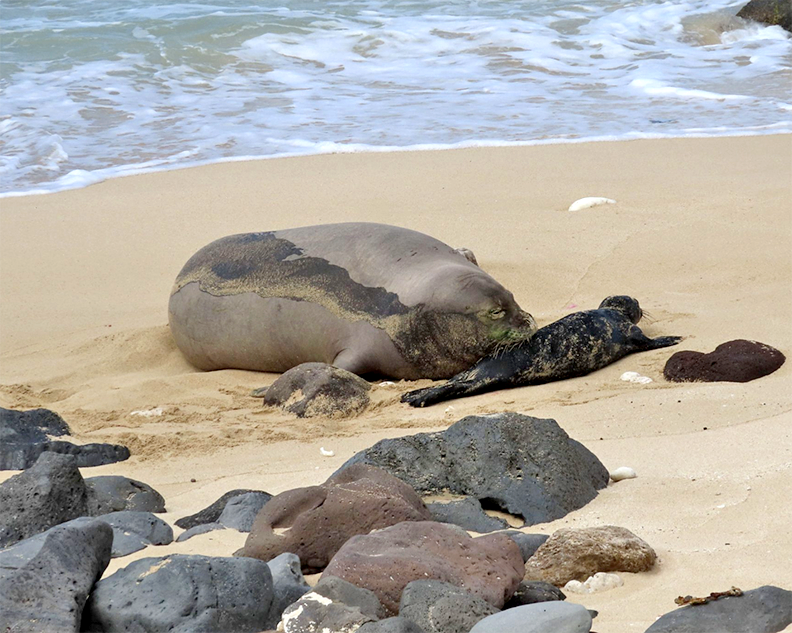By Ruby Pap
 Many of us are aware that global warming is happening. We also get the idea that the world is already experiencing some of the impacts and that they will worsen as time goes by. But what do those impacts actually look like on Kaua‘i and when will they be fully realized?
Many of us are aware that global warming is happening. We also get the idea that the world is already experiencing some of the impacts and that they will worsen as time goes by. But what do those impacts actually look like on Kaua‘i and when will they be fully realized?
Right off the bat, I should say the timing question is pretty complicated. For example, sea levels on Kaua‘i have already been rising at about 1.53 mm/year over the past century (about 9 inches). But this is projected to rapidly accelerate due to melting of the polar ice caps and thermal expansion of the oceans from global warming.
Based on available scientific projections, a general rule of thumb for Hawai‘i is at least 1 foot of sea level rise (SLR) by 2050 and at least 3 feet by 2100 in Hawai‘i. But, this could be even higher (up to 6 feet or more) if we have maximum glacier and ice-sheet loss. Notice the “by xxx time” language and “up to” language. The science just isn’t refined enough to project an exact timescale for Hawai‘i, but it’s amazing to see the amount of papers that come out every day on this subject. It’s hard to keep up!
Let’s not get hung up on timing. The fact is, we are probably already seeing impacts from global warming and they will likely get worse. This includes increased temperatures, increased erosion and increased flooding/drainage issues, and more frequent and severe storms. For a full rundown, see the UH Sea Grant publication, “Climate Change Impacts in Hawai‘i” at http://seagrant.soest.hawaii.edu/sites/default/files/publications/smfinal-hawaiiclimatechange.pdf.

Conceptual diagram of a freshwater lens and marine and groundwater inundation under sea level rising in the Southern O‘ahu aquifer. Rotzoll and Fletcher, 2012.
Take drainage and flooding. SLR will not only manifest itself in surface inundation from waves, but also underground intrusion, whereby the sea pushes up the groundwater and creates new wetlands inland. This will exacerbate existing drainage problems, and possibly cause contaminated drinking water with salt water.
A recent study in Honolulu by Rotzoll and Fletcher in the journal ‘Nature Climate change Letters,’ found that 2 feet of sea level rise would cause substantial groundwater flooding and 3 feet of SLR would cause groundwater to flood at least twice the amount of inundation coming from the ocean.
While it is unclear exactly what scale and timeframe the Hawaiian Islands will experience accelerated sea level rise, there are already clear analogs for the types of impacts that can be expected. On O‘ahu, storm drains flood backwards onto the streets of Waikiki during very high tides. We can expect to see similar tidal flooding in Kauai’s low-lying communities, such as Hanalei, Kapa‘a, Wailua and Waimea. Some historical wetlands that have been drained over the years for agriculture, such as behind Kapa‘a town and on the Mana Plain will be increasingly inundated.
Some areas may see new wetlands where they haven’t been seen before (in human history, at least). Perhaps it’s time to start researching where those areas will be to make informed decisions about development or preservation.
And then there’s beach erosion. About 70 percent of Kaua‘i’s beaches are chronically eroding. With future SLR, the rate of erosion is expected to increase dramatically, but by just how much is the subject of a study currently underway by Dr. Fletcher et al.
So what can we do? A recently published technical study, commissioned by the County of Kaua‘i’s Planning Department to be used in the County’s General Plan and Community Plan updates, addresses some planning and adaptation options that can be taken. I’ll go over a few of these options in future columns. In the meantime, see http://seagrant.soest.hawaii.edu/sites/default/files/publications/web-8-18-14-kc3ha-final.pdf.
- Ruby Pap is a Coastal Land Use Extension Agent at University of Hawai‘i Sea Grant College Program. She can be reached at rpap@hawaii.edu.
Discover more from ForKauaiOnline
Subscribe to get the latest posts sent to your email.





Leave a Reply